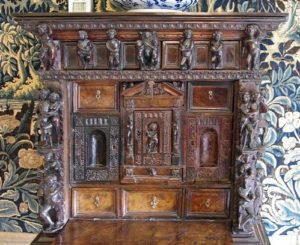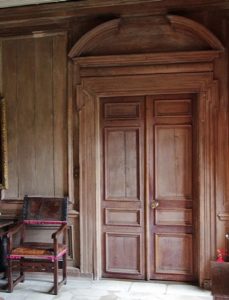This is a lovely setting at the edge of the village on the banks of the River Rye. Baskets of twigs are left by the bridge to play Pooh Sticks – a nice gesture.
It is a simple stone building surrounded by a large walled garden on the south, with orchards and daffodils in flower in March. There are carefully shaped yew trees near the house and large neatly trimmed bushes of box.
There is a beech hedge around the courtyard to the west of the house with the visitor entrance.
The oldest part of the house is the west wing which was built in the 16thC by William Parr, 1st Marquess of Northampton, brother of Catherine Parr. The estate was forfeited after his role in setting Lady Jane Grey on the throne and for a while was let to tenants before being bought in 1655 by Ranald Graham and then inherited by his nephew Richard Graham, 1st Viscount Preston. He remodelled the hall to reflect the latest French architectural fashion.
The hall then passed through a succession of owners until it was inherited in 1920 by Margaret Fife and her husband Col Ronald D’Arcy Fife. They undertook a major renovation and bequeathed it to the National Trust in 1946. The house is displayed in the style of the 1920s with many Fife family pieces.
The ENTRANCE HALL was originally the kitchen but was converted into a grand entrance hall by the Fifes. It still has its stone paved floor and huge open fire place with a log fire burning. On the walls are stag’s heads and there are carved chairs scattered around. The shop and toilets are off to the left.
Steps lead up to the DINING ROOM which had originally have been a bedroom in the days bedrooms were grand living rooms used to receive guests. It has dark green panelled walls with lots of prints. The table is laid with green and white china and crystal. On the side boards are cutlery boxes. Tea is set out on a small wall table.
Beyond is the small WRITING ROOM of the Major with desk, easy chair and more prints on the walls. The ceiling panels have two large painted crests.
The dining room leads into the OAK HALL which runs across the front of the house and was the original entrance hall. It has a stone floor laid out in a pattern of squares and hexagons and oak panelled walls. The fireplace has a large carved stone surround with a shield above an easy chairs around it. There is a large marquetry screen at the base of the staircase. Side tables have display cases with a fan, miniature paintings and mourning broaches.
A splendid oak STAIRCASE with massive bannisters leads up to the first floor. There are tapestries on the walls and a carved chest on the half landing.
The DRAWING ROOM above the oak hall has good views across the walled gardens. It is a light room with pale carpet. By the door is a massive carved lion door stop. The fireplace has a dark wood surround and Meissen figures. There are easy chairs and a sofa around the fireplace and two large tapestries on the walls. On a table was a Master’s Voice gramophone and a 1920s radio playing music. On a wall is a large 1810 dolls house. This was never a children’s toy. It was used by the ladies of the house to arrange and display the beautifully made furniture.
Next is COLONEL FIFE’S BEDROOM with Chinese style wallpaper. This is a fussy design of birds, flowers and fruits. He had a four poster bed with blue drapes and white patchwork cover. He had a small writing desk and small chest with a mirror above and ivory backed brushes. There was a wash bowl set on another table.
MRS FIFE’S BEDROOM is next door. It is a much lighter and more feminine room with pale panelled walls and carpet. She had a four poster bed with a flowery patterned quilt and a painted base board. Above are two violins playing. The travelling dressing table opens up with a mirror and small cupboards. It contained opera glasses, small bead purse and a necklace along with ivory backed hairbrushes and crystal scent bottles. Of the room is a small WRITING ROOM with desk and easy chairs.
Next is the OAK BEDROOM, a small dark room with Tudor panelling on the walls. Above the door is a small window designed to give more light. The four poster bed has linen fold panelling on the head board. A corner fireplace was added later with shelves above to display blue and white china.
The WEST BEDROOM has only been open this year. It has rose patterned wallpaper and a few pieces of furniture. There is a suggestions board asking for ideas what to do with the room.
Downstairs is the REST ADND READ ROOM, with chairs for visitors to sit and rest on. There are glass fronted cabinets containing silverware and Meissen figurines.
The PANELLED BEDROOM contains an army campaign four poster bed which would have been used by an army officer when posted abroad. It could be dismantled and carried from place to place. The canopy allowed a mosquito et to be hung from it at night. The room has oak panelled walls and old oak furniture. Cromwells’ troops used this room and the panelling round the windows was damaged by their swords.
The small room off this may have been a dressing room. Now it is set up as an ORATORY with a small prie dieu.
Off the corridor is a TOILET with large rectangular wooden seat and a separate BATHROOM with large bath with formidable cylindrical plug.
Stairs lead up into the NURSERY with fire place and fire guard. This has a wooden baby’s crib with teddy bear. On the floor is a train set and a table is laid out with a doll’s tea set. The toy cupboard contains toy soldiers, matchbox toys and board game.
More stairs lead up into the roof space with massive wood rafters. The SERVANT’S ROOM has two narrow iron beds dressing table, washstand, cane seated chairs, two tin trunks and a fire place. There is a carpet square on the floor and walls are wallpapered. Between the beds is a framed “Cast thy burden upon the Lord” which must have been appropriate after a long hard day.
A series of rooms contained a PHOTOGRAPHIC EXHIBITION of wildlife pictures. This lead into the CARLISLE COLLECTION. Mrs F M Carlisle started collecting miniature doll’s house furniture from the 1920s. She turned into an avid collector and even commissioned craftsmen to make furniture and rooms for her. In the first room are display cases with some of the furniture she collected including dressers with china or copper cooking utensils and china tea sets. Another room has a display of the different rooms she commissioned. This includes everything from a Queen Anne drawing room, Adam music room. Georgian bedroom to a children’s nursery. It is worth spending time looking at these as the degree of detail is amazing. These were intended for display and not to play with.
The tour finishes in the CHILDREN’S CORNER with paper, pens and pencils. Next to it is the SECOND HAND BOOKS.
The back servants stairs lead back to the shop and tea room. We didn’t investigated either.
Over all we felt it was a fairly unexciting house and a bit disappointing inside. It lacks impact and didn’t inspire the imagination. You do ned to allow time to talk to the room stewards who are wealth of information. There are short information leaflets in each room with basic details. We were pleased that we were able to take pictures inside the house.
This is interesting to visit, but we felt wasn’t a place to draw you back for a second visit. Almost to my surprise, I found the miniature rooms the most interesting.
DISABLED ACCESS
There is designated disabled parking but it is a fair walk to the house across the bridge over the River Rye. The property has two wheelchairs available for visitor use.
There is disabled access to the walled garden, although paths are grassy and the ground slopes uphill slightly.
There is a step into the entrance hall, although there is an accessible entrance available. Once inside however, there is no wheelchair access into the house. Corridors are narrow and there are steps everywhere. A DVD tour is available from reception.
There is no reduction for seniors, however reception told me that a carer is allowed in free with a disabled person.










